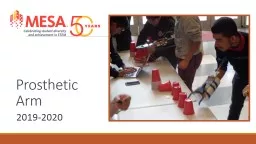

Learning Objectives By the end of the session participants will be able to Explain the rules to students Identify the major bones and joints of the arm and Create a prosthetic arm from available materials to pick up an object ID: 775309
Download Presentation The PPT/PDF document " Prosthetic Arm 2019-2020" is the property of its rightful owner. Permission is granted to download and print the materials on this web site for personal, non-commercial use only, and to display it on your personal computer provided you do not modify the materials and that you retain all copyright notices contained in the materials. By downloading content from our website, you accept the terms of this agreement.
Slide1
Prosthetic Arm
2019-2020
Slide2Learning Objectives
By the end of the session, participants will be able to:Explain the rules to students,Identify the major bones and joints of the arm, andCreate a prosthetic arm from available materials to pick up an object.
Slide3How 3-D printed are changing kid’s lives around the world
https://www.youtube.com/watch?v=XQ8tPOqN7WE
Slide4Prosthetic Arm Rules
Middle School (6 and 7/8)
High School (9/10 and 11/12)
Design, construct, and operate a simulated prosthetic arm
Grab
and release bean bags into Target Zone as fast as possibleOne at a timeDevice must have at least two artificial fingers.At least two fingers must open and closeMust grab and release object
Design, construct, and operate a simulated prosthetic arm
Grab, stack, and release plastic cups into a pyramid in fastest time
One at a time
Device must have at least two artificial fingers
.
At least two fingers must open and close
Must grab and release object
Slide5Prosthetic Arm Rules
Middle School (6 and 7/8)
High School (9/10 and 11/12)
May use any material, except hazardous ones
NOT
controlled or operated by either member’s fingers, hands, or wristsOwn method of immobilization May use unencumbered hand to hold or move bucket
May use any material, except hazardous ones
NOT
controlled or operated by either member’s fingers, hands, or wrists
Own method of immobilization
May use unencumbered hand to hold or move
bucket
Slide6Middle School Competition Area Specs
Plastic All-Purpose bucket
Skeet Ball Target Zone
Bean bags
Count # of bean bags on initial impact inside of scoring zones
Slide7High School Competition Area Specs
Standard six foot table
21 pre-stacked red 16 ounce plastic cold cupsBounce Free and Soft dryer sheetsCount # of cups successfully stacked on second tier or higher at end of trial
Task Area
(60 cm)
Table / Task Area
Working Area
74 cm
180 cm
Slide8Engineering Lab Book
Include sketches of human arm and device iterations with correctly labeled structures.
Include Materials Table.
Slide9Activity: Bones and Joints
Objective: Identify the major bones and joints of the human arm
Slide10Bones and Joints of the Upper Extremity
HumerusThe longest and largest bone in the upper extremityRadiusThe other bone of the forearm, shorter than the ulna.UlnaA long bone in the forearm parallel with the radius; at the proximal is the elbow and the distal end is the wrist.
Shoulder Joint/Complex
Elbow Joint/ComplexHumeroulnar Joint – simple hinge-jointHumeroradial Joint – arthorodial joint allowing gliding and sliding motionsProximal Radioulnar Joint – pivot joint
Slide11Bones of the Hand
CarpalsThe wrist is composed of 8 separate carpal bones.MetacarpalsThe intermediate part of the hand skeleton that is between the carpals and the phalanges (up to the knuckles); 5 metacarpal cylindrical bonesPhalangesThe fingers of the hand contain 14 digital bones.
Slide12Joints of the Hand
Wrist JointRadiocarpal jointCarpometacarpal jointIntercarpal joints
intercarpal
joints carpometacarpal jointmidcarpal jointradiocarpal joint
interphalangeal
joints
Metacarpophalangeal Joints
Interphalangeal Joints
Slide13Activity: Grab and Release an Object
Supplies per Group:2 sheets of card stock paper9 straws14 craft sticks3 pony beadsGeneral Supplies:Various objects such as empty paper clip box and empty water bottleGlue gunScissorsMasking tapeA few bamboo skewersRolls of string
Objective:
Design, build, and operate a prosthetic arm from given supplies to grab various objects one at a time and release them
Slide14Activity: Grab and Release an Object
Using the given supplies, design and build a prosthetic arm to grab and release an object.
Device MUST have at least two artificial fingers.
At least two artificial fingers MUST open and close.
Can NOT use opposite fingers, hand, or wrist OR the real hand to operate or control the prosthetic arm. This is a simulation.
See Activity Sheet for instructions to create one finger with two joints. Your group may create the finger with additional joints.
After creating one finger, your group will create another one or more fingers.
Use the remaining supplies to create the arm and the operation of the fingers.
Attach the prosthetic arm and pick up the different objects from a table one at a time and release.
Slide15Slide16Activity: The Pick-Up Challenge
Supplies per Group:2 cups3 ft of string10 rubber bands1 pair plastic glove10 craft sticks2 sheets of paper10 strawsGeneral Supplies:ScissorsMasking tapeVarious objects to pick up
Objective:
To design and build a prosthetic arm device to safely pick up things.
Slide17Activity: The Pick-Up Challenge
Prosthetic arm must be a working model with moveable parts. Tape cannot be used by itself or as a “lasso” to pick up objects.Must be able to pick up objects without outside assistance.Device must be self-contained (e.g., device cannot be anchored or tethered).Device must be controlled using only one arm or opposite hand.
Slide18Resources / Contact
Rules and curriculum at https://mesa.ucop.edu/ Teach Engineering at https://www.teachengineering.org/ Ben LouieUSC MESA blouie@usc.edu
Slide19